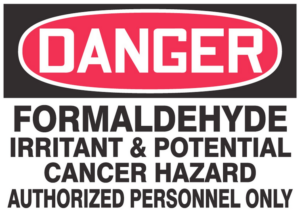What is Formaldehyde?
Formaldehyde is a colorless, reactive, strong-smelling gas at room temperature. It is one chemical in a large family of chemical compounds called volatile organic compounds (VOCs). The term volatile means that the compounds vaporize or become a gas at room temperature.
Formaldehyde can be manufactured as a liquid (formalin) or a solid (paraformaldehyde). Formaldehyde is an important industrial chemical used to make other chemicals and different types of products, such as: home furnishings, household cleaners, paints, textiles, landscape and yard products, medicinal and personal care products, and pesticides. Chemicals that are created with formaldehyde or have formaldehyde added to them include the following:
• resins and lubricants
• polyoxymethylene plastics
• 1,4-butanediol
• methylene diphenyl diisocyanate
Formaldehyde can be released into the air (off-gas) from materials and products made with it. Formaldehyde can also be released into the air by automobiles, cigarettes, and burning wood, kerosene or natural gas. It is also a naturally occurring substance.
Why Should You Be Concerned?
Formaldehyde exposure may potentially cause a variety of symptoms and adverse health effects, such as eye, nose, throat, and skin irritation, coughing, wheezing, and allergic reactions. Long- term exposure to high levels of formaldehyde has been associated with cancer in humans and laboratory animals. Formaldehyde can affect people differently. Some people are very sensitive to formaldehyde at a certain level while others may not have any noticeable reaction to the same level.
Formaldehyde is just one of several gases present indoors that may cause adverse health effects and illnesses. Many other gases, as well as respiratory illnesses (e.g., colds and the flu), can cause similar symptoms to those caused by formaldehyde.
What Levels of Formaldehyde Are Present in Consumer Environments?
Formaldehyde is normally present at low levels, usually less than 0.03 parts per million (ppm), in both outdoor and indoor air. The outdoor air in rural areas has lower concentrations while urban areas have higher concentrations (due to sources such as automobile exhaust). Residences or offices that contain products that release formaldehyde into the air can have levels greater than 0.03 ppm. Read More
Source: Consumer Product Safety Commission





